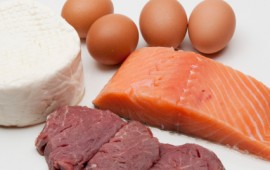How You Can Increase Protein Intake Easily
Author: Shannon Miller Lifestyle

Are you worried that you aren’t getting enough protein?
It is true that women, on average, have a lower intake of protein than men do. Protein is an extremely important part of your diet. Amino acids, the building blocks of protein, do not get stored in your body the way that carbohydrates do. This is important to know because “protein also helps you sustain muscle during weight loss, improve muscle fitness, immunity, and antioxidant function, build HDL Cholesterol, and enhance insulin and leptin function – all of which contribute toward optimal weight management efforts over time,” says Byron J. Richards, Board Certified Clinical Nutritionist.
Common protein sources are easy to find: beef, chicken, pork, turkey, eggs, fish, beans and tofu. But if you find it difficult to consume these types of foods or don’t consume all or any of them due to a special diet, like vegetarian or vegan diets, it may do you some good to check out some of these unexpected sources of protein. Please remember that it is good to eat a variety of foods and not stick to one specific source of a type of nutrient, so try to mix up your food choices!
Cottage Cheese
Cottage cheese consists of casein protein which is a slow release protein that can lasts for hours. Each ½ cup serving contains about 13 grams of protein. Combine that with a serving of fruit like strawberries, blueberries, or pineapple and you have a quick and nutritious breakfast or snack. A plus for cottage cheese is that it is a very inexpensive source of protein.
Greek Yogurt
Greek Yogurt has become a very popular food in the U. S. in recent years, and there is good reason. It contains a whopping 17 grams of protein per serving! It also contains less than half of the carbohydrates of regular yogurt. It is great by itself, with some honey, with some granola, with some fruit, or any of those combinations. It is also a fantastic substitute for sour cream and can even be substituted for mayonnaise on sandwiches.
Smoothies
Smoothies can serve as a fantastic meal replacement. Many smoothie shops now carry different booster options that often include a protein booster. Walk-Fit sponsor, Nutrition Oasis is a great place in Jacksonville to find a delicious smoothie with that extra protein boost, and they also provide a comprehensive weight loss support system with Herbalife products.
Another smoothie recipe: start with some greek yogurt, add a few fruits (or veggies if you are a little more adventurous), a serving of your favorite protein powder, and any extra boosters you want like some flax seeds or nutritional yeast. Throw all of your ingredients with some ice into a blender and you have a quick, high protein smoothie for breakfast. You can also plan ahead and portion and freeze your ingredients ahead of time, use ice cube trays to make 1 oz frozen portions of yogurt and use frozen fruits to replace the need to use ice.
Ice Cream
You probably are thinking, ice cream?? How is that a protein dense food source??
Well, it is true that regular ice cream does have some protein in it, up to about 4-5 grams per serving, but Naturally Smart Frozen Dessert has 9-10 grams of protein per serving, which is double that of regular ice cream, it also has about one-third the amount of fat in regular ice cream. Naturally Smart is all-natural, gluten-free, and it is also delicious! It currently is available in only vanilla and chocolate, but there are more flavors coming soon.
Fruits and Vegetables
Surprisingly, fruits and vegetables can be a good source of protein too. Particularly leafy green vegetables like spinach or broccoli have a good amount of protein. Artichoke, corn, and potatoes also contain a good amount of protein. Fruits usually contain less protein than other food sources, but fruits can also contain protein. Cantaloupe, strawberries, naval oranges, bananas, and watermelon in particular contain more protein than other fruits.
Other Protein Sources
Legumes and nuts are always a good source of protein. Soybeans are the number 1 source of plant protein. Lima beans, kidney beans, navy beans, black beans, lentils and other types of legumes can on average contains over 15 grams of protein per serving.
Protein bars are also convenient protein sources when you are in a pinch. Just be sure to always read the ingredients because these type of protein sources can be extremely processed.
